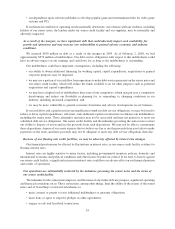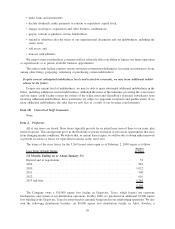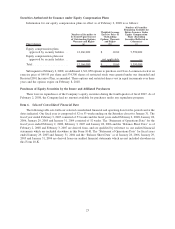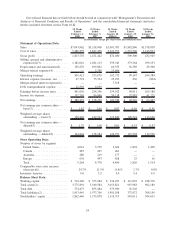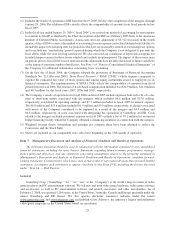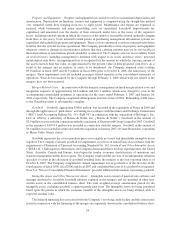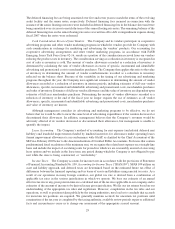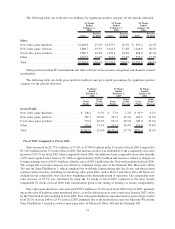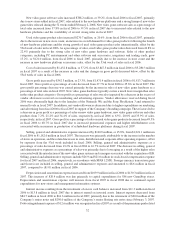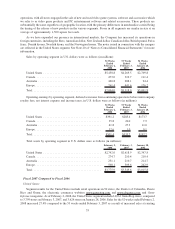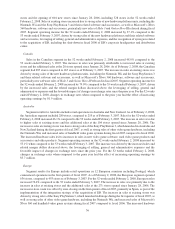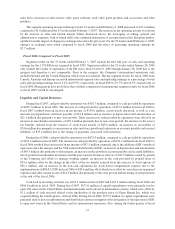GameStop 2007 Annual Report Download - page 42
Download and view the complete annual report
Please find page 42 of the 2007 GameStop annual report below. You can navigate through the pages in the report by either clicking on the pages listed below, or by using the keyword search tool below to find specific information within the annual report.related software and accessories will increase in the future. The Company’s gross margin in fiscal 2007 and fiscal
2006 was adversely impacted by the recent launches of these new products and subsequent manufacturer-funded
retail price decreases for some of these products.
Critical Accounting Policies
The Company believes that the following are its most significant accounting policies which are important in
determining the reporting of transactions and events:
Use of Estimates. The preparation of financial statements in conformity with GAAP requires man-
agement to make estimates and assumptions that affect the reported amounts of assets and liabilities, the
disclosure of contingent assets and liabilities at the date of the financial statements and the reported amounts of
revenues and expenses during the reporting period. In preparing these financial statements, management has
made its best estimates and judgments of certain amounts included in the financial statements, giving due
consideration to materiality. Changes in the estimates and assumptions used by management could have
significant impact on the Company’s financial results. Actual results could differ from those estimates.
Revenue Recognition. Revenue from the sales of the Company’s products is recognized at the time of
sale. The sales of used video game products are recorded at the retail price charged to the customer. Sales
returns (which are not significant) are recognized at the time returns are made. Subscription and advertising
revenues are recorded upon release of magazines for sale to consumers and are stated net of sales discounts.
Magazine subscription revenue is recognized on a straight-line basis over the subscription period. Revenue
from the sales of product replacement plans is recognized on a straight-line basis over the coverage period. Gift
cards sold to customers are recognized as a liability on the balance sheet until redeemed.
Stock-Based Compensation. In December 2004, the Financial Accounting Standards Board (“FASB”)
issued Statement of Financial Accounting Standards No. 123 (Revised 2004), Share-Based Payment,
(“SFAS 123(R)”). This Statement requires companies to expense the estimated fair value of stock options
and similar equity instruments issued to employees in its financial statements. The Company adopted the
provisions of SFAS 123(R) using the modified prospective application method beginning on the first day of
fiscal 2006. Under SFAS 123(R), the Company records stock-based compensation expense based on the grant-
date fair value estimated in accordance with the original provisions of Statement of Financial Accounting
Standards No. 123, Accounting for Stock-Based Compensation, and previously presented in the pro forma
footnote disclosures, for all options granted prior to, but not vested as of, the adoption date. In addition, the
Company records compensation expense for the share-based awards issued after the adoption date in
accordance with SFAS 123(R). As of February 2, 2008, the unrecognized compensation expense related
to the unvested portion of our stock options and restricted stock was $13.7 million and $18.8 million,
respectively, which is expected to be recognized over a weighted average period of 0.8 and 1.9 years,
respectively. Note 1 of “Notes to Consolidated Financial Statements” provides additional information on
stock-based compensation.
Merchandise Inventories. Our merchandise inventories are carried at the lower of cost or market using
the average cost method. Under the average cost method, as new product is received from vendors, its current
cost is added to the existing cost of product on-hand and this amount is re-averaged over the cumulative units.
Used video game products traded in by customers are recorded as inventory at the amount of the store credit
given to the customer.
In valuing inventory, management is required to make assumptions regarding the necessity of reserves
required to value potentially obsolete or over-valued items at the lower of cost or market. Management
considers quantities on hand, recent sales, potential price protections and returns to vendors, among other
factors, when making these assumptions. Our ability to gauge these factors is dependent upon our ability to
forecast customer demand and to provide a well-balanced merchandise assortment. Any inability to forecast
customer demand properly could lead to increased costs associated with inventory markdowns. We also adjust
inventory based on anticipated physical inventory losses or shrinkage. Physical inventory counts are taken on a
regular basis to ensure the reported inventory is accurate. During interim periods, estimates of shrinkage are
recorded based on historical losses in the context of current period circumstances.
27




